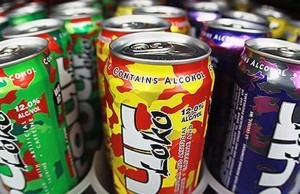 Underage drinkers of flavored alcoholic beverages who exclusively consume the supersized versions are more than six times as likely to report suffering alcohol-related injuries compared to underage youth who drink other types of alcoholic beverages, according to a new study from researchers with the Center on Alcohol Marketing and Youth (CAMY) at the Johns Hopkins Bloomberg School of Public Health and the Boston University School of Public Health.
Underage drinkers of flavored alcoholic beverages who exclusively consume the supersized versions are more than six times as likely to report suffering alcohol-related injuries compared to underage youth who drink other types of alcoholic beverages, according to a new study from researchers with the Center on Alcohol Marketing and Youth (CAMY) at the Johns Hopkins Bloomberg School of Public Health and the Boston University School of Public Health.
Flavored alcoholic beverages, also known as alcopops, can be classified into three categories: malt-based flavored beverages (e.g., Mike’s Hard Lemonade or Smirnoff Ice); spirits-based premixed, ready-to-drink cocktails (e.g., Jack Daniel’s cocktails); and supersized alcopops (e.g., Four Loko or Joose). Supersized alcohol beverages can contain the equivalent of between four and five alcoholic drinks.
Drink size does not appear to be the only factor at work. The researchers found that among underage drinkers, those who reported three types of exclusive flavored-alcoholic-beverage use–pre-mixed/ready-to-drink cocktails only, supersized alcopops only, and any combination of two or more flavored alcoholic beverages–were more likely to consume a higher number of drinks per day, to drink more days in a month, and to engage in heavy episodic drinking.
The report, published Feb. 25, 2015, in the American Journal of Public Health, is believed to be the first study to document an association between the consumption of different types of flavored alcoholic beverages by youth ages 13-20, risky drinking behaviors, and self-reported injuries related to alcohol consumption. In previous studies by the same researchers, nearly half of underage drinkers in the United States reported having consumed flavored alcohol beverages in the past 30 days.
“It is impossible to discuss harmful alcohol consumption among youth and not include supersized alcopops,” said study co-author David Jernigan, PhD, director of the Center on Alcohol Marketing and Youth at the Johns Hopkins Bloomberg School of Public Health. “These low-priced and sweet-tasting beverages are associated with reports of dangerous consequences among youth.”
For their study, the researchers surveyed 1,031 underage youth, ages 13-20, who had consumed at least one drink of alcohol during the past 30 days between December 2011 and May 2012. In an online, self-administered survey, respondents identified what brands of alcohol they had consumed in the past 30 days, the number of days on which each brand was consumed, and the typical number of drinks of each brand that were consumed on those days. Heavy episodic drinking was reported by nearly 70 percent of pre-mixed/ready-to-drink cocktail users, by about 75 percent of supersized alcopop users, and by almost 80 percent of those who consumed more than one type of flavored alcoholic beverage, compared with 45 percent of non-flavored-alcohol-beverage users. Consumption of any combination of two or more flavored alcoholic beverage was also strongly associated with reports of heavy episodic drinking, fighting, and alcohol-related injuries.
“These findings raise important concerns about the popularity and use of flavored alcoholic beverages among young people, particularly for the supersized varieties,” said study author Alison Albers, PhD, an assistant professor at the Boston University School of Public Health. “Public health practitioners and policymakers would be wise to consider what further steps could be taken to keep these beverages out of the hands of youth.”
Alcohol is the most commonly used drug among youth in the United States and is responsible for the deaths of approximately 4,300 underage persons each year. Approximately 33 percent of eighth graders and 70 percent of twelfth graders have consumed alcohol, and 13 percent of eighth graders and 40 percent of twelfth graders drank during the past month.
